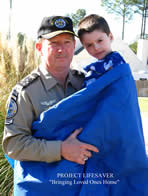
Teen Wins Award For A Coding Program
In 2020, Sreenidi Bala, a teenager from Farmington, Connecticut, started a passion project that would change the lives of hundreds of autistic students.
Keeping our children safe is a top priority and it is even a greater concern when a child has been diagnosed with an autism spectrum disorder (ASD). Some people with ASD are prone to wander away from their caregivers, which can make keeping them safe even more difficult. A 2011 national survey done by Dr. Paul Law at the Kennedy Krieger Interactive Autism Network found that 50 percent of parents of children with autism reported that their child had a tendency to wander. Of that 50 percent, nearly half said their child went missing long enough to cause significant concern. If a person is lost and not found within 24 hours, the chance for serious injury and even death is grows significantly.
How do you protect your child from wandering off?
What if your child wanders off despite your precautions? Project Lifesaver may be able to help.
Project Lifesaver International is a nonprofit organization that provides law enforcement, fire/rescue, and other first responders and caregivers with equipment and training in order to quickly locate and rescue individuals with cognitive disorders who wander.
Individuals enrolled in Project Lifesaver wear a PAL device, a small personal transmitter around the wrist or ankle that emits an individualized tracking signal. To date, Project Lifesaver agencies have conducted nearly 3,000 successful rescues with a 100 percent success rate.
The Project Lifesaver program provides first responders with an understanding of the symptoms and behaviors of the individuals they help to find. They know how to approach the individual, gain their trust, and put them at ease for the trip home. Project Lifesaver trains, certifies, and equips first responders to assess and effectively manage the safe and comfortable return of the individual.
Project Lifesaver operates through local agencies, which you can
find in the “Where We Are”section of the Web site under the “About Us” dropdown. You can also call Project Lifesaver at 757-546-5502.
The program is not free. The costs to enroll an individual vary by agency. Some agencies participate in grant programs, which may be able to provide the PAL devices at discounted rates or at no charge to you and your loved one.
As a parent of a special needs child, reach out to your local law enforcement and first responders, establish a relationship, and provide them with information regarding your child. As parents, you are most in tune with your child. You should have up-to-date information and photos made available to first responders in advance of emergencies. When it comes to an elopement or wandering episode, you can be the greatest asset to helping officials during this critical time.
Being prepared for a potential wandering episode and working directly with your local law enforcement and other first responders will not only better protect your child but also give you greater peace of mind.
 Gene Saunders is the founder and chief executive officer of Project Lifesaver International. He is a military veteran and a retired law enforcement captain. During his long military and law enforcement career, he has seen the issue of wandering by special needs individuals essentially ignored, leaving individuals with autism who are prone to wandering at risk. For that reason, for the past 15 years, he has been extensively and exclusively working on this important singular issue.
Gene Saunders is the founder and chief executive officer of Project Lifesaver International. He is a military veteran and a retired law enforcement captain. During his long military and law enforcement career, he has seen the issue of wandering by special needs individuals essentially ignored, leaving individuals with autism who are prone to wandering at risk. For that reason, for the past 15 years, he has been extensively and exclusively working on this important singular issue.